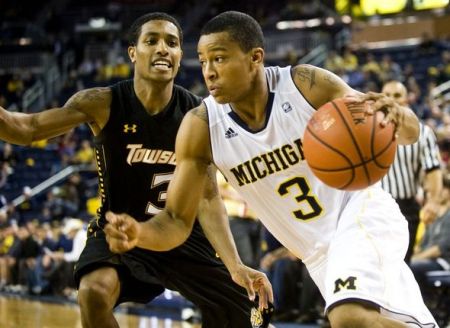Key Observations From Michigan’s Tough Four-Game Stretch
Posted by Deepak Jayanti on February 13th, 2013Deepak is a writer for the Big Ten microsite of Rush The Court. Follow him on Twitter for more about B1G hoops at @dee_b1g.
Playing four games over the course of 11 days is not an easy task for any basketball team, especially true if the games are in the toughest conference in the nation. What the Michigan Wolverines had to go through since February 2 can’t be compared to any normal four-game stretch because they faced three of the top Big Ten teams — Indiana, Wisconsin, and Michigan State — in front of thousands of raucous fans which can be very exhausting. As if those road games were not enough, they arguably played in the most competitive game of the league season against Ohio State in Ann Arbor. Two weeks ago, we knew that John Beilein’s squad would be tested during these games but the match-ups turned out to be much tougher for the Wolverines than anticipated. Three road games which included two overtimes have given us a very good sample to understand the strengths and weaknesses John Beilein’s team and the following are three key observations since Michigan’s game two Saturdays ago against the Hoosiers.
- Good defensive teams will let Trey Burke beat them, but only from the perimeter. Burke is shooting 38% from beyond the arc which is a decent long-range shooting percentage but the three-ball is not his forte. Rather, he is most dangerous once he gets by his defender into the paint and has three options: pull up for a jumper from the high post, kick it out to Nik Stauskas or Glenn Robinson in the corner, or drive all the way to the basket to draw the foul. Except for a few pick-and-roll plays with Mitch McGary, Burke hasn’t had much success consistently driving to the basket over last few games and all of the credit goes to good scouting and defense by Victor Oladipo, Aaron Craft, Ben Brust and Keith Appling. He scored 19.5 PPG during the four games but also attempted an average of eight shots from beyond the arc, which indicates a tendency to settle for poor shot selection to some extent. If he can consistently hit the step-back three, opposing teams will gladly let him beat them that way because it is not as high a percentage shot for a player with Burke’s gifts. By keeping Burke on the perimeter, the Wolverines’ threat from the corners are also neutralized, which hurts the offensive games of Robinson and Stauskas.
- Glenn Robinson has not been effective against top defensive teams. It is tough to blame Robinson too much for his slump because there are no set plays called specifically for him in the half-court. The 6’7’’ wing mostly benefits from kick-out passes from Burke’s dribble penetration or just uses his pure athleticism to score in transition. When Burke is locked up defensively and the transition game is taken out of the equation by good defense, Robinson appears to be clueless in the offense. He’s averaged just 4.5 PPG and shot just 28% from the field since the Indiana game. Fatigue may have also played a role because he was asked to defend such athletic forwards such as Christian Watford, Deshaun Thomas and Branden Dawson. Let’s not forget that he is still a freshman but he will need to learn how to be more effective while burning a lot of calories defending athletic forwards on the other end of the floor.
- Michigan’s interior defense and rebounding was exposed. Cody Zeller and Derrick Nix are two of the best centers in the Big Ten, so it shouldn’t be surprising that the Michigan frontcourt struggled against them. But the Buckeyes’ Amir Williams and Badgers’ Jared Bergren scored nine and 13 points too, respectively. At the outset, Williams’ statistics may not be impressive but during the game’s second half and the overtime, he looked very comfortable in the post against Mitch McGary and Jon Horford. Williams had one of his best games in Ann Arbor which shows that Beilein lacks a strong interior presence on the defensive end — possible trouble in March. Michigan was out-rebounded 142-115 during these four games and the other title contenders outside of the Big Ten such as Florida, Duke and Kansas should be taking note of this particular weakness.
Losing three out of four games against teams ranked in the top 20 should not lead to any panic. Burke and company will get another shot at Michigan State and Indiana in Ann Arbor during early March and it will be interesting to see the adjustments they make during the rematch. This losing skid may end up proving very beneficial to Beilein’s team because the Wolverines now understand their soft spots and can spend most of the rest of February implementing tweaks to their offense before preparing for the postseason. Better to learn now about certain issues than in late March if you are one of the favorites to win the national title.












































